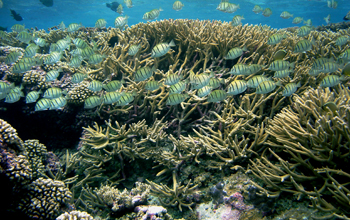Multimedia Gallery
Reef-building Acropora Corals (Image 1)
Reef-building corals support an oasis of life and diversity in a sparse ocean. Because branching Acropora corals such as those pictured here in the central Pacific Ocean are in peril from climate change, the whole ecosystem is in danger of collapse. [See related image Here.]
More about this image
The decline in coral reefs in recent years due to a variety of threats -- from pollution to climate warming -- has lent urgency to the search for new ways to evaluate their health. A new study by Scripps Institution of Oceanography (at the University of California, San Diego) scientists has revealed that fluorescence, the dazzling but poorly understood light produced by corals, can be an effective tool for gauging their health.
This research was supported by a grant from the National Science Foundation's (NSF) Integrative Graduate Education and Research Traineeship (IGERT) program (grant DGE 03-33444), an NSF Graduate Research Fellowship, awarded to Melissa Roth, and the Air Force Office of Scientific Research's Natural Materials, Systems and Extremophiles program. Birch Aquarium at Scripps provided the corals and technical support for the experiments.
To learn more about this research, see the UC-San Diego news story Fluorescent Light Revealed As Gauge of Coral Health. (Date of Image: 2006)
Credit: Melissa Roth, Scripps Institution of Oceanography, University of California, San Diego
See other images like this on your iPhone or iPad download NSF Science Zone on the Apple App Store.
Images and other media in the National Science Foundation Multimedia Gallery are available for use in print and electronic material by NSF employees, members of the media, university staff, teachers and the general public. All media in the gallery are intended for personal, educational and nonprofit/non-commercial use only.
Images credited to the National Science Foundation, a federal agency, are in the public domain. The images were created by employees of the United States Government as part of their official duties or prepared by contractors as "works for hire" for NSF. You may freely use NSF-credited images and, at your discretion, credit NSF with a "Courtesy: National Science Foundation" notation.
Additional information about general usage can be found in Conditions.
Also Available:
Download the high-resolution JPG version of the image. (4.8 MB)
Use your mouse to right-click (Mac users may need to Ctrl-click) the link above and choose the option that will save the file or target to your computer.



